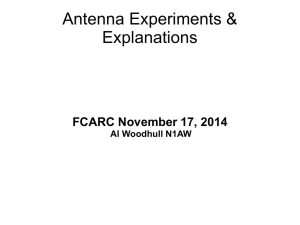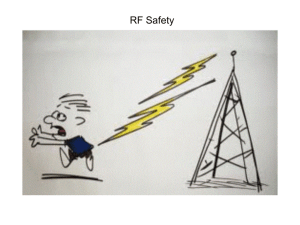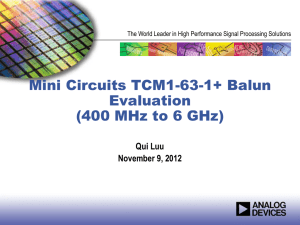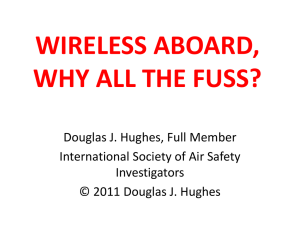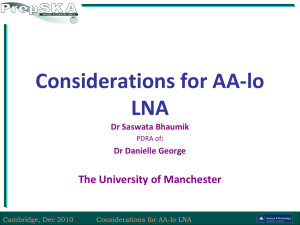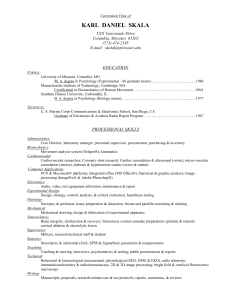SKALA: A log-periodic antenna for the SKA-AAlo
advertisement
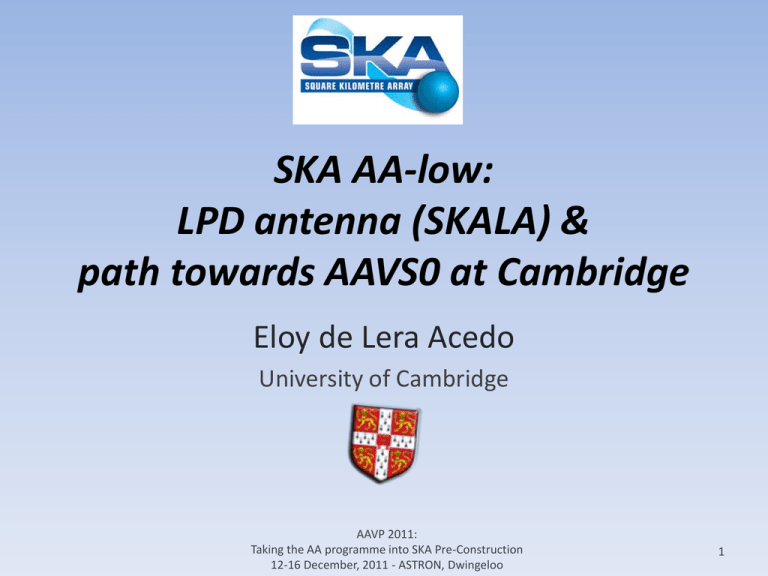
SKA AA-low: LPD antenna (SKALA) & path towards AAVS0 at Cambridge Eloy de Lera Acedo University of Cambridge AAVP 2011: Taking the AA programme into SKA Pre-Construction 12-16 December, 2011 - ASTRON, Dwingeloo 1 Overview • • • • • • Introduction Current status of SKALA (LPD antenna) Low Noise Amplifier for SKALA SKALA tests and AAVS0 (16-element array) Important numbers Summary and conclusions Introduction Parameter Specification Remarks Low frequency MHz 70 Nyquist frequency MHz 100 Frequency with element spacing is λ/2, defines max Aeff High frequency MHz 450 Freq where sky noise is low, overlaps with AA-hi and/or dishes Frequency coverage Bandwidth, max contiguous MHz Polarisations 380 2 Station diameter m 180 Geometric area m2 ~25,000 No. of element types 1 No. of elements Scan angle range ~10k deg ±45 m2/K 17 Frequency channel kHz 250 Output data rate Tb/s 16 Sensitivity @ 100 MHz Lowest frequency expected for the EoR There are no gaps between low and high frequency Individual beams can operate over the full frequency range Orthogonal Determined from SKA2. Uses 250 arrays for expected SKA2 sensitivity A single wide-band element type e.g. bow-tie or conical spiral Each element is low gain, dual polarisation Will operate at larger scan angles, but sensitivity not defined Single array, sensitivity varies over the band. Assumes Tsky= 1000K, 70% for appodisation. Assumes 2048 channels splitting the full sample rate, further channelization will be required at correlator Defines the survey performance of the array. Can be used flexibly for frequency, bandwidth and number of beams Evolution: from BLU to SKALA Impedance Dual polarisation Sky coverage Cost BLU Impedance Impedance Dual polarisation Dual polarisation Sky coverage Sky coverage Cost Cost Toothedw-SKALA log periodic Impedance Dual polarisation Sky coverage Cost SKALA SKALA: SKA Log-periodic Antenna 1.6 m 1.3 m * GND mesh is 1.5 x 1.5 m. Current status of SKALA Mass production of SKALA and LNA Mass production of SKALA and LNA • Some numbers: – Cost of antennas for AAVS1 is around 150€/element. – Cost of antenna for AAVS2 is targeted at 75€/element (this is for the 2 polarisations and includes the electronics). – Weight of each arm would be 1.56 kg if made of steel wire. First prototype Performance 0 Simulation Measurement -2 -4 S11 /dB -6 -8 -10 -12 -14 -16 -18 -20 0.1 0.08 0.150.1 0.2 0.12 0.25 0.14 0.3 Freq Freq/GHz /GHz 0.35 0.16 0.4 0.18 0.450.2 Low Noise Amplifier for SKALA • Frequency range 70 to 450MHz • Gain > 20dB • Gain flatness, as flat as possible consistent with meeting other spec. parameters • Noise temperature < 30K at 450MHz • P1dB, high enough to allow astronomical observations to be made at Lords Bridge • Power consumption < 100mW • Unconditionally stable at both input and output ports • Differential source (antenna), single-ended load • High Level of Common Mode Signal Rejection Concept Diferrential input LNA1 Static discharge path DC block LNA2 Balun Coaxial output Dual Matched Low Noise RF FETs Required AVAGO MGA-16516 Schematic Board layout Picture LNA & antenna performance DB(NFCIR(1,0.1)) LNA_MGA16516_all_in_one.$FSWP1 S(1,1) SKALA_CCL_5_simple_1polLoaded_Wing_diff_metalPoleGood_nonMetal.$FPRJ Swp Max 450MHz 2. 0 6 0. 0. 8 1.0 Antenna S11 and LNA Noise Circles 0. 4 450 MHz r 1.58135 x -0.032405 0 3. 0 4. 5. 0 0. 2 10 .0 5.0 4.0 3.0 2.0 1.0 0.8 0.6 0.4 70 MHz r 0.462591 x -0.236854 p2 p7 p2: FREQ = 70 MHz NF = 0.63953 dB p3: FREQ = 130 MHz NF = 0.41355 dB p4: FREQ = 130 MHz NF = 0.51355 dB p5: FREQ = 300 MHz NF = 0.41005 dB p5 p3 -1 0. 0 2 -0 . p6 4 .0 -5 . 0 0 0.2 p1 10.0 p8 p1: FREQ = 70 MHz NF = 0.53953 dB p4 -3 .0 -1.0 -0 .8 -0 .6 .0 -2 .4 -0 Swp Min 70MHz p6: FREQ = 300 MHz NF = 0.51005 dB p7: FREQ = 450 MHz NF = 0.43003 dB p8: FREQ = 450 MHz NF = 0.53003 dB LNA+antenna simulated performance (includes a 20dB gain second stage on chip) SKA Lo LNA Transducer Gain and Noise Figure in dB 50 Operating with Cambridge Log Periodic 448.3 MHz 40.94 dB 40 70 MHz 44.1 dB DB(NF()) LNA_MGA16516_all_in_one.$FPRJ dB 30 DB(GT()) LNA_MGA16516_all_in_one.$FPRJ 20 70 MHz 0.7654 dB 449.3 MHz 0.4301 dB 10 0 70 170 270 Frequency (MHz) 370 450 LNA+antenna simulated performance (includes a 20dB gain second stage on chip) Noise Figure of SKA Lo LNA operating with Cambridge Log Periodic 0.8 DB(NF()) LNA_MGA16516_all_in_one.$FPRJ 70 MHz 0.7654 dB Noise Figure dB 0.7 0.6 255.2 MHz 0.4608 dB 0.5 449.5 MHz 0.4301 dB 103.3 MHz 0.4528 dB 0.4 70 170 270 Frequency (MHz) 370 450 Simulated A/T for SKA 1 (with log-periodic antenna) - A/T shown is A/T of 1 antenna x N (number of antennas in a 180 m station with elements spaced 1.5 m apart) x 50 stations. • η (radiation efficiency) = 90% • D (directivity) • Tsky (sky noise temperature) following Tsky = 1.691*(freq[GHz].^-2.751) + 4.875 K • Tamb (ambient temperature) = 295 K • Trec (receiver noise temperature) -> Assuming ideal amplifier with: • Zopt (optimum noise impedance) = 100 Ω • Rn (noise resistor) = 10 Ω • Fmin (minimum noise figure) = 0.3 dB -> 21 K A/T for polarization 1 [m 2/K] for SKA1 (based on SKALA) @ 170 MHz 1 200 400 600 800 1000 1200 1400 1600 1800 2000 2200 0.8 0.6 sin( )*sin( ) 0.4 0.2 2400 0 -0.2 30o -0.4 45o -0.6 60o -0.8 * Peak is at 2452 m^2/K -1 -1 200 -0.5 0 sin( )*cos() 0.5 1 A/T for polarization 2 [m 2/K] for SKA1 (based on SKALA) @ 170 MHz 1 0.8 200 0.6 0 0 2400 0.2 0 -0.2 30o -0.4 45o -0.6 60o 20 0 sin( )*sin( ) 0.4 200 220 0 20 640000 8 1 00 120000 140 0 160 0 0 180 0 -0.8 * Peak is at 2452 m^2/K -1 -1 -0.5 0 sin( )*cos() 0.5 1 A/T Stokes I [m2/K] for SKA1 (based on SKALA) @ 170 MHz 1 500 100 0 150 0 0.8 200 0.6 0 2500 sin( )*sin( ) 0.4 3000 0.2 3400 0 -0.2 30o -0.4 45o -0.6 60o -0.8 * Peak is at 3468 m^2/K -1 -1 -0.5 0 sin( )*cos() 0.5 1 A/T Stokes I [m2/K] for SKA1 (based on SKALA) 4000 Zenith 30o 3500 45o 60o 3000 A/T /m2/K 2500 2000 1500 1000 500 0 0.05 0.1 0.15 0.2 0.25 Freq /GHz 0.3 0.35 0.4 0.45 Effect of Soil/GND – (Soil B – 5% humidity) Even a bigger pitch may be possible! 120 10 cm pitch 5 cm pitch No ground 100 Tgnd /K 80 60 40 20 0 0.1 0.15 0.2 0.25 Freq /GHz 0.3 0.35 0.4 0.45 X-pol 0 Zenith 22.5 o H-plane -5 22.5 -10 x-pol /dB -15 o E-plane 45 o H-plane 45 o E-plane -20 -25 -30 -35 -40 -45 -50 0.1 0.15 0.2 0.25 Freq /GHz 0.3 0.35 0.4 0.45 SKALA tests and AAVS0 • 16 dual-polarised SKALA elements. • Aim: – Test realistic SKA AA-low front-end technology in an array environment: • Effect of cables. • Effect of ground mesh/soil. • Effect of mutual coupling on noise and pattern. – Challenges: • Measure the pattern in an array environment. Options: – Use of known field source: NF, FF. – Use data from interferometry experiment. ADC: 1GS/s 50 -100m all optical – Cost: • Estimated total cost is 5-10 K€ depending on tools and equipment needed for the tests. e/o Data e/o Control e/o Sync. Analogue Lord’s Bridge Observatory SKALA-AAVS0 Upcoming tests: • December 2011: – Impedance test with “dummy” board. • January 2011: – – – – Single element pattern measurement in outdoor test range, Perth? Single element pattern measurement in outdoor test range, UK. Noise matching with integrated LNA in reverberation chamber, UK. Impedance tests on AAVS0. • February-March 2011: (with Roach back-end) – Noise tests on AAVS0: pointing the array to hot and cold patches of the sky. – Pattern tests on AAVS0: (compare with analytical/EM models - UCL) • Interferometry experiment: full correlation/correlation with high gain antenna • Known source: Near field source (no back-end needed), minicopter? – More tests... Any suggestion? Plug into other back-ends? Important numbers • Noise: – <30 K @ 450 MHz. • Sky coverage – A/T: – Meets DRM specifications down to +/- 45o at all frequencies. • Frequency band: – Potential to go down to 50 MHz (lower arm). • Foot-print: 1x1 m possible (lower arm). • Cost: – Targeted to 75 € including LNA and ground mesh. Single-Dual band • Low-band: high gain element, OK. • High-band: low gain element? Not so easy... Getting down to 30 K with a low gain antenna in a 3:1 band is not that easy. You will probably need a high gain element anyway and rather large. Summary and conclusions • Antenna+LNA pair meets DRM requirements. • In early 2012 noise and pattern tests for AAVS0. • Mass production prototypes are in their way (75€/element). Thank you! Any questions? SKALA1 (Cambridge) SKALA2 (ICRAR) SKALA0 miniSKALA (Cambridge) SKALA3 (Cambridge) SKALA4 (ASTRON)
